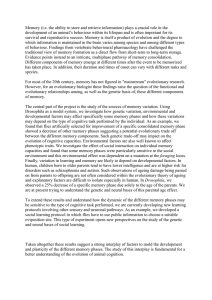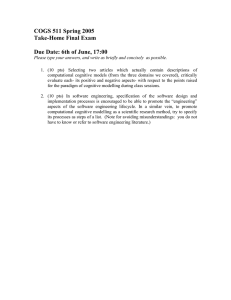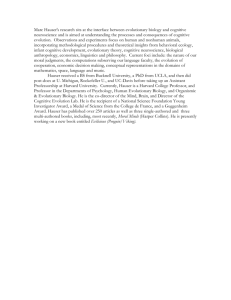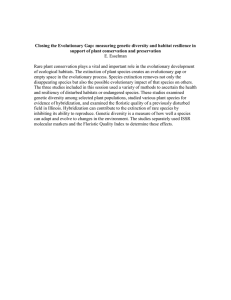CHAPTER 1 INTRODUCTION Motivation
advertisement
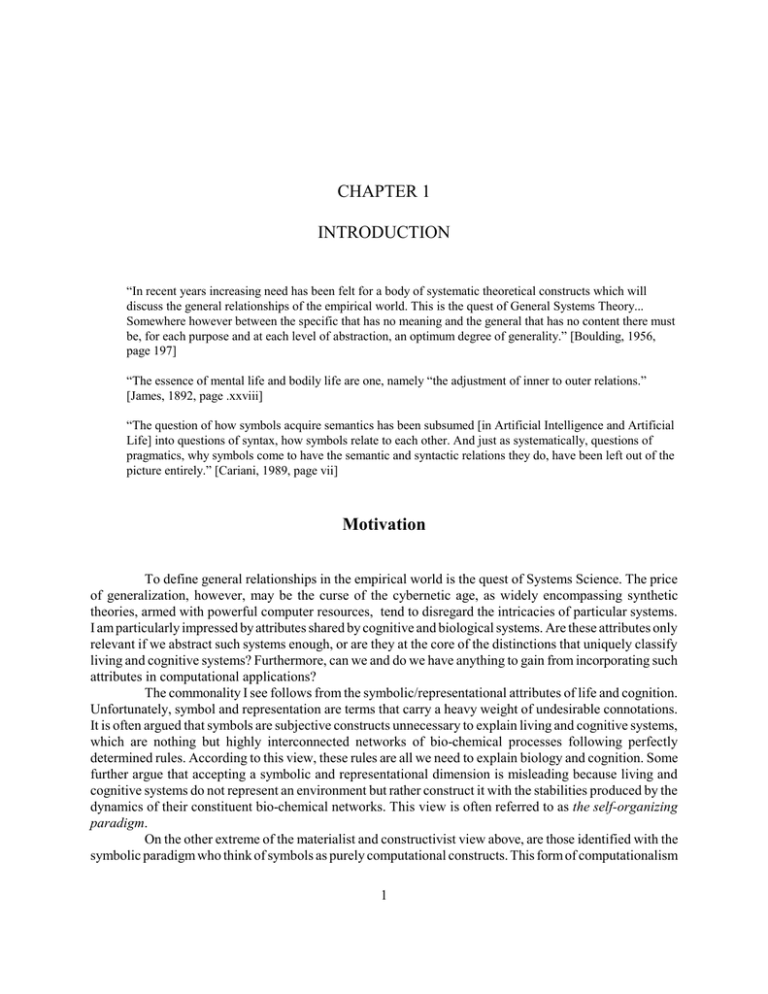
CHAPTER 1 INTRODUCTION “In recent years increasing need has been felt for a body of systematic theoretical constructs which will discuss the general relationships of the empirical world. This is the quest of General Systems Theory... Somewhere however between the specific that has no meaning and the general that has no content there must be, for each purpose and at each level of abstraction, an optimum degree of generality.” [Boulding, 1956, page 197] “The essence of mental life and bodily life are one, namely “the adjustment of inner to outer relations.” [James, 1892, page .xxviii] “The question of how symbols acquire semantics has been subsumed [in Artificial Intelligence and Artificial Life] into questions of syntax, how symbols relate to each other. And just as systematically, questions of pragmatics, why symbols come to have the semantic and syntactic relations they do, have been left out of the picture entirely.” [Cariani, 1989, page vii] Motivation To define general relationships in the empirical world is the quest of Systems Science. The price of generalization, however, may be the curse of the cybernetic age, as widely encompassing synthetic theories, armed with powerful computer resources, tend to disregard the intricacies of particular systems. I am particularly impressed by attributes shared by cognitive and biological systems. Are these attributes only relevant if we abstract such systems enough, or are they at the core of the distinctions that uniquely classify living and cognitive systems? Furthermore, can we and do we have anything to gain from incorporating such attributes in computational applications? The commonality I see follows from the symbolic/representational attributes of life and cognition. Unfortunately, symbol and representation are terms that carry a heavy weight of undesirable connotations. It is often argued that symbols are subjective constructs unnecessary to explain living and cognitive systems, which are nothing but highly interconnected networks of bio-chemical processes following perfectly determined rules. According to this view, these rules are all we need to explain biology and cognition. Some further argue that accepting a symbolic and representational dimension is misleading because living and cognitive systems do not represent an environment but rather construct it with the stabilities produced by the dynamics of their constituent bio-chemical networks. This view is often referred to as the self-organizing paradigm. On the other extreme of the materialist and constructivist view above, are those identified with the symbolic paradigm who think of symbols as purely computational constructs. This form of computationalism 1 defines representation as the mapping of categories from one domain to another: from environmental to genetic or mental categories. It thus ignores the material constraints of biological and cognitive systems, which are considered irrelevant to define such systems, accepting genetic and mental categories as mirroring (through the mapping) real world categories. The term representationalism has been identified with this view. I shall argue that both representational and self-organizing approaches avoid the central issue of how matter and symbols co-evolve. Representationalism denies the particular aspects of a system’s embodiment, while the self-organizing paradigm refuses to accept the evolutionary advantage of a pragmatic (selected), symbolic, relationship with an environment. I believe that an inclusive approach should be pursued which considers the syntactic, semantic, and pragmatic aspects of living and cognitive systems. Pragmatism is understood as a context-dependent, multi-level constraint satisfaction of material, developmental, and evolutionary requirements. Furthermore, this semiotic approach though general enough to encompass biology and cognition, should offer a set of specific requirements to distinguish living and cognitive systems from other complex systems, defining a valid systems theoretic conceptual framework. My motivation is precisely geared to add some more concepts and tools for the establishment of such a framework already proposed by other systems researchers with similar goals. The aim of the present work is to advance arguments to substantiate the view that the modeling of cognitive and biological systems should utilize concepts emanating from both the self-organizing and representationalist paradigms. Indeed, both paradigms offer only an incomplete account of the nature of life, biological or cognitive, which is given a more realistic explanation when both paradigms are understood as complementary. Philosophical and conceptual arguments are given to substantiate this inclusive position, and how it relates to a web of existing philosophical viewpoints. The position is strengthened by the definition of mathematical and computational formalisms which show its relevance in the creation of practical computational applications for information technology. Preliminary Background1 Traditionally, Artificial Intelligence (AI) and Artificial Life (AL) have been associated with a computational approach to cognition and biological systems. Models involve systems that manipulate symbols which stand for external observables: a representational scheme. This manipulation follows computational rules, and has lead to the idea of mind and life as a program. With this approach, the particular substrate which implements symbols and rules is irrelevant as long as the desired computation is achieved. It is usually referred to as the Symbolic or Computational Paradigm. The alternative view, brought back to life in the 1980's with the revival of earlier cybernetic ideas, uses physical laws as the basis of its models. It attempts a dynamic explanation of cognition and life by building models inspired by the dynamics of the brain and living matter. The functions that the symbolic paradigm attempts to directly represent and compute, are seen on this alternative approach as emergent properties of the dynamics. It is usually referred to as a Connectionist, Emergent, Dynamic, Subsymbolic, or Self-Organizing Paradigm: "One of the most interesting aspects of this alternative approach in cognitive science is that symbols, in their conventional sense, play no role. In the connectionist approach, symbolic computations are replaced by numerical operations – for example, the differential equations that govern a dynamical system. These 1 This subsection follows essentially my introduction to the special edition of Communication and Cognition - Artificial Intelligence, Self-Reference in Biological and Cognitive Systems [Rocha, 1995a, page 3-8]. 2 operations are more fine grained than those performed using symbols; in other words, a single, discrete symbolic computation would, in a connectionist model, be performed as a result of a large number of numerical operations that govern a network of simple units. In such a system, the meaningful items are not symbols; they are complex patterns of activity among the numerous units that make up the network." [Varela, Thompson, and Rosch, 1991 page 99] The early 1990's were prolific in debates on the differences between the Symbolic and Connectionist paradigms [e.g. Ramsey, Stich, and Rumelhart, 1991 (eds); Dinsmore, 1992 (ed)]. Today, in most of AI, these distinctions have boiled down to the opportunistic utilization of techniques from both camps according to particular aspects of designed applications. Applied AI journals and magazines will just as likely publish the latest advances in expert systems driven by logic engines (classical, modal, or fuzzy), as the latest neural network, cellular automata, or genetic algorithm schemes. In fact, hybrid architectures tend to be the most favored items found on these publications. On a more conceptual level, it has been generally accepted that looking at cognition with symbolic or dynamic tools is a question of finding a comfortable level of description for the properties we desire to model. Those working within a symbolic paradigm are most often preoccupied with models of natural language and human reasoning and categorization processes, while those utilizing dynamic tools focus on pattern recognition and dynamic classification models. In theoretical biology, evolutionary systems theory, or AL, a similar feud is defined between those that understand life as essentially a genetic variation engine subjected to natural selection (neo-Darwinism, functionalism) [e.g. Dawkins, 1987; Maynard-Smith, 1986; Dennett, 1995], and those that stress that life is essentially a property of the self-organization and development of dissipative material structures (structuralism) [e.g. Thom, 1975; Nicolis and Prigogine, 1977; Haken, 1977; Maturana and Varela, 1987; Kauffman, 1991; Goodwin, 1994]. Unlike what happens in cognitive science, in evolutionary systems theory it has been somewhat easier to propose inclusive approaches based on the hierarchical aspects of biological systems [e.g. Gould, 1989; Pattee, 1974; Salthe, 1985, 1993], though none of these proposals has had the widespread success of the genetic reductionism view. The symbolic paradigm of AI and the genetic reductionist approach of evolutionary systems can be referred to generally as the representationalist view of life and cognition. Basically, it is based on the existence of discrete, static, entities that linearly stand for phenotypic traits in a living system they uniquely define, or for real world categories that a cognitive system must classify. Natural selection is the process that statistically biases these symbolic entities in population distributions of living systems, resulting in increased phenotypic adaptation to a given environment. The symbolic nature of the heritable results of natural selection, has lead to the widespread success of genetic models of artificial living systems which do not depend on a specific materiality [Langton, 1989]. Cognitive science has not been as lucky in defining an overall process responsible for the adaptation of mental to real world categories, or learning. Natural selection is proposed as an engine for phylogenetic learning in theories of evolutionary epistemology [Lorenz, 1981, Campbell, 1987, Wuketits, 1990] and even account for grammatical constraints of language [Pinker, 1993]. Ontogenetic learning is still very much the subject of theoretical strife. Regardless of the true nature of learning, representationalism considers that mental categories essentially mirror real world categories, and that the material aspects of cognitive systems are largely irrelevant. The Connectionist paradigm of current day cognitive science, and the structuralist approach to evolutionary systems can be referred to generally as the self-organizing view of life and cognition. It is based on the existence of networks of simple components following simple state-transition rules, whose dynamic global behavior is essentially dependent on a small number (compared to the number of components) of dynamic basins of attraction. The process that leads the system from any initial state to one of the basins of attraction is understood as self-organization. These basins of attractions are not localized in identifiable components, but distributed and superposed [van Gelder, 1991] through the whole network. In evolutionary 3 systems, this view emphasizes that life is largely dependent on the spontaneous organization of order which exists with or without natural selection. Further, evolution is believed to be restricted to the dynamic trajectories of these systems, that is, the history of the attractor landscape of a given dynamics as its structure is perturbed. This implies that not all phenotypic traits, regardless of their fitness in an environment, can be obtained, unless they stem from the set of possible dynamical stabilities in a given dynamic trajectory. In cognitive systems, this view likewise stresses that classification of an environment depends on the existence of dynamic stabilities of connectionist systems. Only those aspects of the environment whose interaction with the network lead to internal stabilities can be recognized and classified. The morphology of living systems and the classification capabilities of connectionist systems are considered to be emergent properties of a complicated dynamics. That is, a multitude of highly interrelated simple components produce a dynamic behavior not completely described by the operative rules of the components. Morphology and classification are said to be emergent properties of self-organizing networks. But are emergent properties nothing but a different way to look at the complicated dynamics responsible for this emergence (reductionism), or do these properties establish a genuinely novel and distinct organization? At first glance, and if we desire to maintain the non-dualist, materialist, tenets of modern science, we seem to have no choice but to accept the reductionist stance expressed on the first interpretation of emergent properties: everything is ultimately explained by a lower-level dynamic set of laws and distinctions between levels exist only in the eye of the beholder who chooses to work on a particular level of description. The question is thus one of explanatory power and of levels of description. The present work elaborates the view that emergent properties, though embedded on some lower dynamics, present a true novel organization which is not completely derivable from the lower level descriptions. The notion of emergence here defended is based on the explanatory power of different levels of description, and it is akin to Clark’s [1996] recent ideas, which are related to Rosen [1985, 1995] and Cariani’s [1989] emergence relative to a model framework. Particularly relevant is the concept of emergent classification which is discussed in detail. I shall argue that emergent classification can be improved when classifying systems are capable of establishing a clear form of symbolic interaction (semiosis) with their environments, which is both effectively representational and dynamically constructed. The argument for this situated semiosis is strongly grounded on Von Neumann's [1966] self-reproducing automata scheme, which is an argument for construction under symbolic control, as well as on an extended formulation of his Parts Problem. Stricter definitions of emergence exist (for a deeper discussion see Cariani [1989], Salthe [1991]), but to pursue my argument, the explanatory notion of emergence will suffice. Both representational and self-organizing approaches to living and cognitive systems avoid the concept of semiosis. Representationalism denies the particular aspects of a system’s situated embodiment with its contextual constraints, while the self-organizing paradigm refuses to address the utility of the concept of symbol and its evolutionary relationship with an environment. I call for an inclusive approach that considers the syntactic, semantic, and pragmatic aspects of biological and cognitive life. To do this, I develop mathematical and computational tools that improve the simulation of certain mental and biological processes beyond pure representational or pure self-organizing models. These models are imbedded in a selection-grounded Constructivist framework. In other words, classification of an environment is highly dependent on the classifier’s dynamical structure, it is not fully open-ended or based on mappings of real world categories to internal categories, but a result of internal construction of stabilities. However, there must be an element of effective representation, or the classifier system would not survive and reproduce in a given environment. This constructed, contextual, intentionality is a result of some form of selection by the environment, which I call evolutionary constructivism. 4 Aims and Claims More explicitly, the aim of the present work is to advance an inclusive framework for the systemstheoretic study of biological and cognitive systems that utilizes both self-organization and representation. Such undertaking is pursued by: a. b. c. d. Arguing the necessity of complementary levels of description for complex systems (emergence). Arguing for a more complete understanding of symbol and representation based on the three semiotic dimensions of syntax, semantics, and pragmatics. Showing that the coupling of symbolic controls to material self-organization defines enabling and restraining constraints on the living organization. Developing models with self-organizing and symbolic characteristics for AI and AL and investigate their computational advantages. The following is the list of the claims that are defended in the present dissertation in order to establish this framework named Embodied, Evolving Semiosis: a. b. c. d. e. The living organization requires a system of structural perturbation of self-organizing dynamics, to be able to evolve new classifications (cognitive or phenotypical) of its own interaction with an environment. If the system of structural perturbation is symbolic, then this evolution is open-ended. Material symbol systems (used for the system of structural perturbation) are constrained in what can be represented in them. Evidence Sets model cognitive categories which establish a system of structural perturbation of long-term, connectionist memory banks. Contextual Genetic Algorithms model material genetic systems and their enabling and restraining constraints. These claims are approached in different ways. a and b are defended by means of a synthetic gathering of evidence from several existing theories. c is argued in the same way as a and b, but is also validated by results from the formal models defined for points d and e, which are implemented computationally. Next, an outline of the organization of the dissertation is given. Outline I intend the present work to be organized in a semiotic way with semantic, syntactic, and pragmatic areas made explicit. This way, the problem is explored philosophically, formally, and computationally respectively. I do not expect the three areas to fully support one another. The philosophical part lays out the problem in general terms and proposes conceptual arguments that should stand on their own. The formal parts, can also stand alone since they represent mathematical constructs valid in their own right. In any case, they are proposed as formal tools to deal with certain aspects of the larger philosophical issues. Finally, the computational parts give some pragmatic validation to certain aspects of the formal tools, by creating computational models of the larger conceptual issues as well as practical applications valid on their own. These computational applications, useful for the fields of data-mining and optimization algorithms, offer the desired pragmatic validation of the philosophical positions advanced. In so doing, they show that there are 5 important advantages to be gained from more inclusive, complementary, theories of artificial intelligence and artificial life that acknowledge both self-organization and representation. The philosophical and conceptual part of the dissertation starts with a discussion of the divisions between representationalism and self-organization. Self-organization is presented within a framework of emergence and of levels of description. The constructivist position is examined in this context. I introduce the notion of selected self-organization as the backbone of the evolutionary constructivist position, and defend the existence of a symbolic dimension as a pragmatic result to increase the effectiveness of selected self-organization. I further discuss how these ideas relate to the study of natural language and evolutionary systems. Following these ideas, I next propose an evolving semiotic conceptual framework for this inclusive form of self-organization with both representational and constructed facets. With natural language in mind, I develop a mathematical tool based on fuzzy set and evidence theories called evidence set, proposed as a more accurate model of cognitive categorization processes. Evidence sets extend interval valued fuzzy sets to a belief based framework, creating a method of formally modeling the contextual constraints of cognitive categories. Evidence sets are representational artifacts, but are also constrained by subjective belief structures, which are two key elements of evolutionary constructivism. In addition, evidence sets capture all forms of uncertainty recognized in generalized information theory, uncapturable by other set structures. Finally, an extended theory of approximate reasoning is proposed based on set-theoretic operations defined for evidence sets. With evolutionary systems and artificial life in mind, I discuss the idea of contextual genetic algorithms. These computational models of natural selection are based on the existence of intermediate levels between genotype and phenotype. In other words, genetic descriptions do not encode directly for phenotypic traits, but for the boundary conditions of intermediate dynamical systems which self-organize into a set of phenotypical traits. The indirect encoding of solutions for a particular problem in genetic algorithms is Figure 1: Dissertation Layout 6 referred to as contextual since the intermediate dynamical systems may depend on inputs other that just the genetic description, such as environmental observables. That is, expression of chromosomes to solutions does not depend solely on genetic information, but also on the system’s context. Indirect genetic encoding is not only a more biologically correct model of genetic natural selection, but it also allows the evolution of different solutions from the same descriptions, which is important for adaptation, and additionally yields tremendous genetic information compression. Furthermore, conceptually, the marriage of selection and selforganization is the crux of evolutionary constructivism in evolutionary systems theory. In order to validate evidence sets and contextual genetic algorithms as relevant models, I explore them computationally in a number of problem areas. Evidence sets are utilized in the development of a search method which acts on several relational databases. This search is based on the reduction of uncertainty stemming from conflicts between the information stored in the various databases which define several contexts. Contextual genetic algorithms are utilized in two distinct models. The first a model of RNA editing which shows that environmental factors can control genetic translation ontogenetically. The second an indirect encoding scheme based on fuzzy logic designed to attain important information compression of genetic descriptions, which is validated in the evolution of neural networks and cellular automata. Both of these models show how the specific materiality of evolutionary systems, or embodiment, both constrains and enables emergent, evolutionary, classification, which is the thrust of evolutionary constructivism. The general layout of the dissertation is organized according to figure 1, where chapter 2 refers to the philosophical discussion of evolutionary constructivism and selected self-organization, chapters 3 and 4 refer to the mathematical discussion of evidence sets and contextual genetic algorithms, chapter 5 refers to the computational models developed, and chapter 6 refers to the final discussion of all the issues discussed before. The following table condenses the organization of the present work. Topics by Chapter Chapter 2 Selected Self-Organization and Evolutionary Constructivism Biological and Cognitive Systems Require Both SelfOrganization and Symbolic Representation. Chapter 3 Evidence Sets and Cognitive Categorization The ideas of chapter 2 are explored mathematically to deal with the modeling of cognitive categories, which are defined as temporary, subjective constructions grounded in several contexts. Evidence Sets are extensions of Fuzzy Sets defined to better simulate cognitive categories within a logic of belief that captures conveniently all forms of uncertainty recognized Chapter 4 Contextual Genetic Algorithms The ideas of chapter 2 are explored formally to deal with the modeling of Natural Selection seen as a process that is both dynamic (material) and symbolic (representational) Chapter 5 Computer Applications Practical results are obtained by using the concepts of chapters 3 and 4 to relational databases and evolutionary computation algorithms Chapter 6 Embodied, Evolving Semiosis: Discussion The results from chapter 5 are discussed by emphasizing the shortcomings of purely computational models of the ideas defended in chapter 2 7 Application Areas The problem areas discussed in this dissertation pertain broadly to the areas of cognitive science, evolutionary systems, and information technology. In particular, to fuzzy logic and evidence theory, as well as evolutionary and adaptive computation and self-organizing systems. The mathematical structures developed have applications to artificial intelligence, reliable computation, relational databases, artificial life, and modeling and simulation. The computational models created have implications for Data Mining, Fuzzy Logic, Genetic Algorithms, Neural Networks, and Cellular Automata. 8
